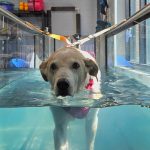Do All Dogs Know How to Swim?
Swimming is often considered a natural skill for dogs. Images of Labradors joyfully diving into lakes, or Spaniels energetically paddling through rivers, reinforce the idea that all dogs are born swimmers.
However, the truth about dogs and swimming is more nuanced. While many dogs have a natural inclination to swim, not all dogs are born with this skill, and some may need assistance or training to feel comfortable in the water. Let’s delve into the various factors that influence a dog’s ability to swim, discuss the breeds that excel in water and offer tips for helping your dog become a confident swimmer.
Natural Instinct to Swim
Many dogs have a natural instinct to paddle when placed in water. This instinct is often referred to as the “dog paddle” and involves a coordinated movement of the front and back legs.
This reflexive action can be seen in puppies when they are first introduced to water. However, while the paddling motion is instinctive, it does not necessarily mean that every dog is a proficient swimmer. The ability to swim confidently and efficiently can vary significantly from one dog to another.
Factors Influencing a Dog’s Ability to Swim
Breed and Physical Characteristics
Certain breeds are naturally better swimmers due to their physical build and historical roles. Breeds like the Labrador Retriever, Newfoundland and Portuguese Water Dog have webbed feet, water-resistant coats, and strong, muscular builds that make them excellent swimmers.
These breeds were historically used for tasks that involved water, such as retrieving game from water or performing water rescues.
On the other hand, breeds with short legs, heavy chests or flat faces may find swimming more challenging. Bulldogs, for instance, have a heavy, muscular build and short legs that make it difficult for them to stay afloat.
Similarly, brachycephalic breeds like Pugs and French Bulldogs may struggle with breathing while swimming, due to their flat faces and short snouts.
Individual Temperament
A dog’s temperament and personality can also play a significant role in their swimming ability. Some dogs are naturally curious and adventurous, making them more likely to enjoy and excel at swimming.
Others may be more cautious or fearful of water, requiring more time and patience to become comfortable with swimming.
Early Exposure and Experience
Early exposure to water can greatly influence a dog’s comfort level with swimming. Puppies that are introduced to water in a positive and controlled environment are more likely to develop a love for swimming.
In contrast, dogs that have had negative experiences with water, or have not been exposed to it until later in life, may be more apprehensive.
Breeds That Excel in Water
Several dog breeds are known for their excellent swimming abilities. These breeds often have physical traits that make them well-suited for aquatic activities. Some of the top swimming breeds include:
• Labrador Retriever: Labrador Retrievers are perhaps the most famous water-loving dogs. They have webbed feet, a thick, water-resistant coat, and a powerful build that makes them natural swimmers. Labradors were originally bred to retrieve game from water, and their love for swimming is deeply ingrained.
• Newfoundland: Newfoundlands are large, powerful dogs with a natural affinity for water. They have webbed feet, a dense double coat, and a strong, muscular build. Newfoundlands were historically used for water rescues, and their calm and gentle temperament makes them excellent swimmers.
• Portuguese Water Dog: As their name suggests, Portuguese Water Dogs have a strong connection to water. They have webbed feet, a curly, water-resistant coat, and a robust build. Portuguese Water Dogs were originally bred to assist fishermen, performing tasks such as retrieving nets and carrying messages between boats.
• Golden Retriever: Golden Retrievers, like Labradors, are known for their love of water. They have a dense, water-repellent coat and a strong, athletic build. Golden Retrievers are often used in water-related activities such as dock diving and water retrieval.
• Chesapeake Bay Retriever: Chesapeake Bay Retrievers are another breed with a strong affinity for water. They have a dense, oily coat that provides insulation and repels water, as well as a powerful build and webbed feet. Chesapeake Bay Retrievers were bred to retrieve waterfowl from the icy waters of the Chesapeake Bay.
Breeds That May Struggle with Swimming
While many breeds excel in the water, others may find swimming more challenging due to their physical characteristics. Some breeds that may struggle with swimming include:
• Bulldogs: Bulldogs have a heavy, muscular build and short legs, making it difficult for them to stay afloat. Their broad chests and short snouts can also make breathing more challenging while swimming.
• Pugs: Pugs are brachycephalic, meaning they have short snouts and flat faces. This can make breathing more difficult while swimming. Additionally, their compact, muscular build and short legs can make swimming more challenging.
• Dachshunds: Dachshunds have a long body and short legs, which can make swimming more difficult. Their low-to-the-ground build can make it harder for them to keep their head above water.
• Boxers: Boxers are muscular and athletic but have a deep chest and relatively short legs. This build can make swimming more challenging for them, especially if they are not introduced to water at an early age.
Teaching Your Dog to Swim
If your dog is not a natural swimmer, or has never been exposed to water, you can still teach them to swim. Here are some tips for helping your dog become a confident swimmer:
• Start Slowly: Introduce your dog to water gradually. Begin with shallow water where they can stand comfortably and gradually move to deeper water as they become more comfortable. Use positive reinforcement, such as treats and praise, to encourage them.
• Use a Life Jacket: A doggy life jacket can provide added safety and help your dog feel more secure in the water. Look for a life jacket with a handle on the back, which can help you guide your dog and lift them out of the water if needed.
• Be Patient: Every dog is different, and some may take longer to become comfortable with swimming. Be patient and take your time, allowing your dog to progress at their own pace. Never force your dog into the water or create a negative experience.
• Use Toys and Games: Using water toys and games can make the learning process more enjoyable for your dog. Fetch toys that float or play games that involve splashing in the water can help your dog associate water with fun and positive experiences.
• Supervise Always: Always supervise your dog when they are in or near water. Even strong swimmers can get into trouble, and it’s important to be there to assist if needed. This is especially important in open water, where currents and other hazards can pose a risk.
Safety Tips for Dogs in Water
Ensuring your dog’s safety in and around water is crucial. Here are some important safety tips to keep in mind:
• Know Your Dog’s Limits: Not all dogs are natural swimmers, and even those that are can become tired or overwhelmed. Know your dog’s limits and avoid pushing them too hard. Allow them to take breaks and rest when needed.
• Avoid Strong Currents: Strong currents, tides, and waves can be dangerous for dogs. Avoid areas with strong currents and be mindful of changing conditions in open water.
• Provide Fresh Water: Ensure your dog has access to fresh water to drink. Drinking saltwater or contaminated water can make your dog sick. Encourage your dog to drink fresh water before and after swimming to stay hydrated.
• Rinse After Swimming: After swimming, rinse your dog with fresh water to remove chlorine, salt, and other chemicals that can irritate their skin and coat. This is especially important if your dog has been swimming in a pool or ocean.
• Use Sunscreen: Just like humans, dogs can get sunburned. If your dog has a light coat or exposed skin, consider using a pet-safe sunscreen to protect them from harmful UV rays.
Aqua Pups Charlotte: Teaching Your Dog to Swim
If you live in the Charlotte or surrounding area and are looking for a place to teach your dog how to swim, Aqua Pups Charlotte is the perfect solution.
Aqua Pups Charlotte is the only indoor pool just for dogs, offering a safe and controlled environment for your furry friend to learn to swim.
Located at 2328 Crownpoint Executive Drive, Suite B, Charlotte, NC 28227, Aqua Pups Charlotte provides a range of services to help your dog become a confident swimmer.
Their experienced staff uses positive reinforcement techniques to ensure a fun and stress-free experience for your dog. Whether your dog is a beginner or needs to improve their swimming skills, Aqua Pups Charlotte can help.
Click the link above to fill out and submit the intake form and one of our swim instructors will reach out to schedule your pup’s orientation and get them swimming.
For more information, call (704) 935-7877. Aqua Pups Charlotte is committed to providing a safe and enjoyable environment for dogs of all breeds and skill levels to learn to swim.
Conclusion
While many dogs have a natural inclination to swim, not all dogs are born with the ability to swim confidently and efficiently. Factors such as breed, physical characteristics, temperament, and early exposure to water can influence a dog’s swimming ability.
Teaching your dog to swim can be a rewarding experience that provides both physical and mental benefits. By starting slowly, using positive reinforcement, and taking safety precautions, you can help your dog become a confident swimmer. Remember, swimming can be a fun and enriching activity for your dog, and with the right approach and resources, any dog can learn to enjoy the water.











